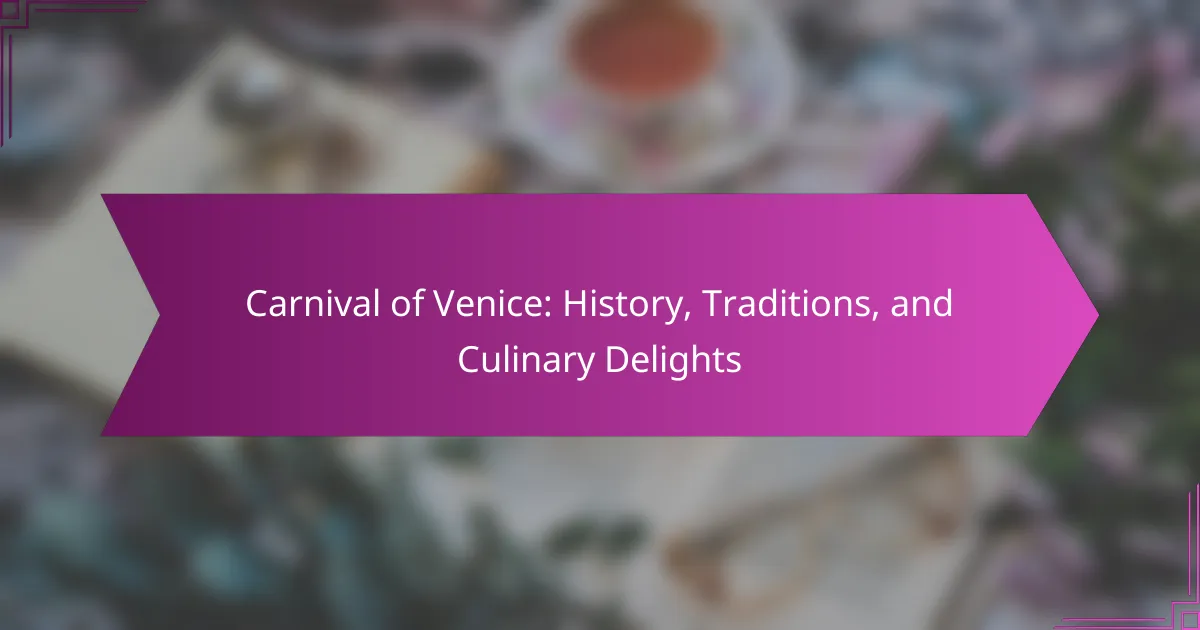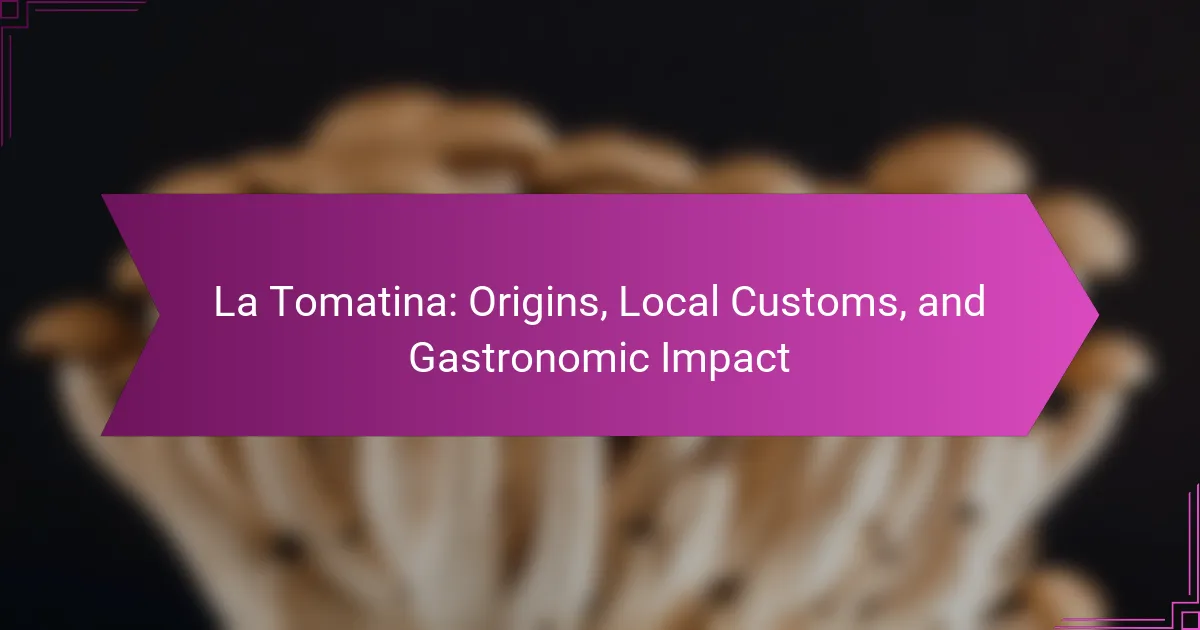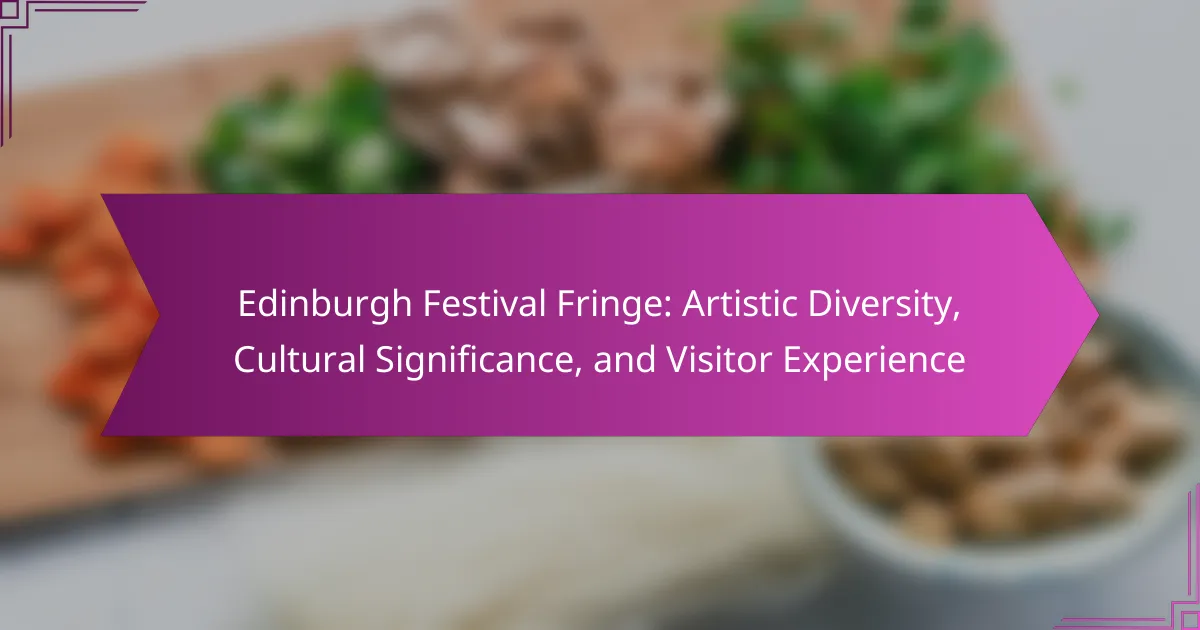Fête de la Musique offers a unique opportunity to experience global musical diversity and community engagement. The event celebrates various genres, showcases local artists, and promotes cultural exchange. It also highlights environmental awareness through sustainable practices and has evolved to include digital platforms for broader participation. This vibrant festival fosters social cohesion while enhancing cultural identity across the world.
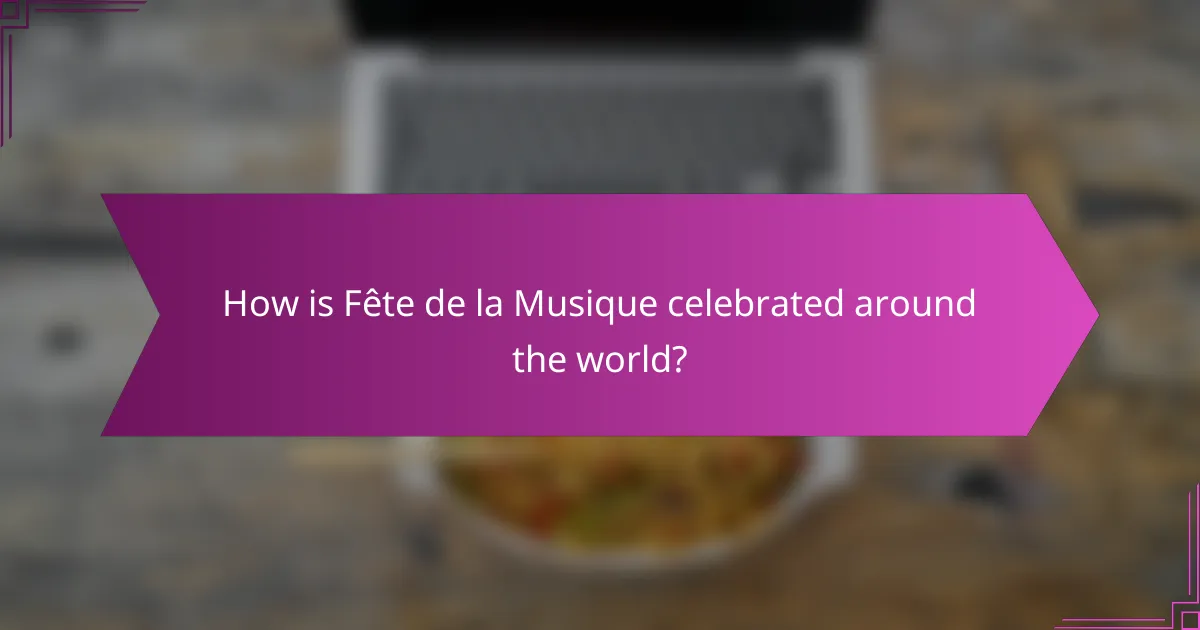
How is Fête de la Musique celebrated around the world?
Fête de la Musique is celebrated globally with diverse musical performances and cultural expressions. Cities worldwide host free concerts, featuring local artists and genres. In France, the event originated in 1982, promoting music accessibility. Countries like Germany and Brazil showcase unique traditions, blending local styles with international influences. In Japan, street performances highlight traditional instruments, while in South Africa, community events celebrate local rhythms and genres. This global celebration fosters cultural exchange and appreciation for music’s universal language.
What are the key features of Fête de la Musique events?
Fête de la Musique events feature free concerts, diverse musical genres, and community participation. These celebrations promote cultural exchange and local talent, highlighting the global impact of music. Events often include performances in public spaces, encouraging inclusivity and creativity. The unique aspect is the emphasis on amateur musicians alongside professionals, fostering a sense of community engagement.
Which countries have the most vibrant celebrations?
Countries with the most vibrant celebrations of Fête de la Musique include France, Brazil, and India. These nations showcase diverse musical styles and cultural expressions during the event.
France, the birthplace of Fête de la Musique, holds grand street performances in cities like Paris, featuring genres from classical to contemporary. Brazil celebrates with lively samba and bossa nova, reflecting its rich cultural heritage. India incorporates traditional and modern music, showcasing regional diversity.
Other notable countries include Germany, where cities host open-air concerts, and Australia, known for its community-focused events. Each country’s unique approach enhances the global celebration of music and culture.
How do local cultures influence the festivities?
Local cultures significantly shape the Fête de la Musique through unique musical expressions and traditions. Each region showcases its distinct genres, instruments, and performance styles, reflecting local heritage. For example, France highlights diverse folk music, while Latin American countries incorporate vibrant rhythms. This fusion enriches the global celebration, creating a tapestry of sounds. Local customs, such as dance and attire, further enhance the festivities, fostering community engagement and cultural pride. As a result, the event becomes a platform for cultural exchange and appreciation worldwide.
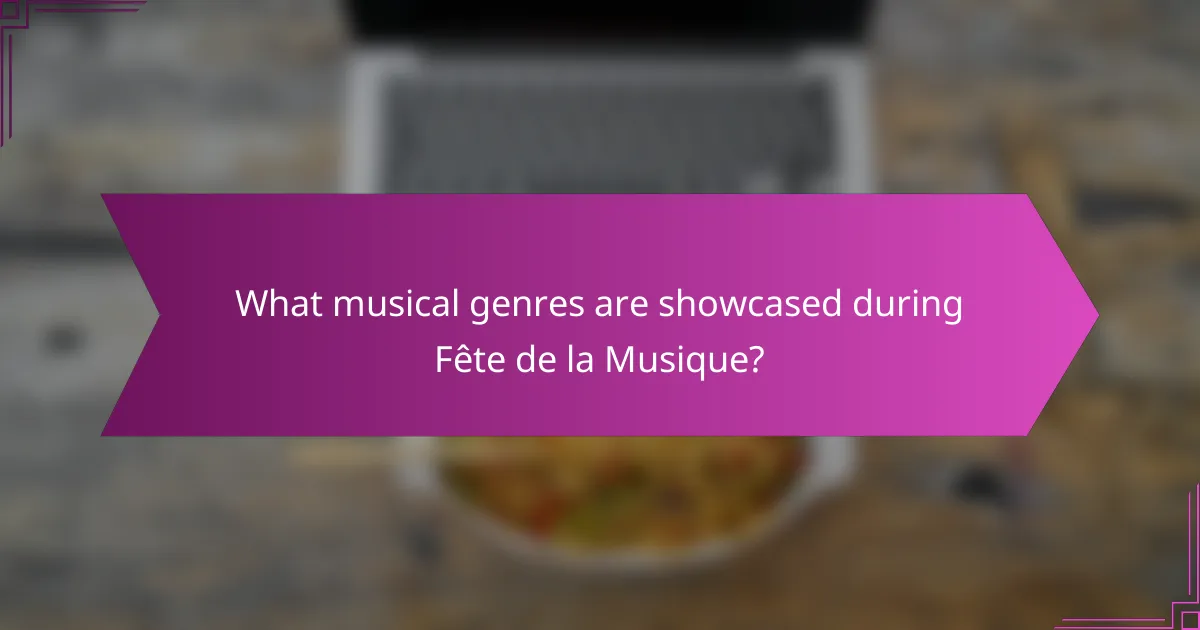
What musical genres are showcased during Fête de la Musique?
Fête de la Musique showcases a wide range of musical genres, including rock, jazz, classical, electronic, folk, and world music. This diversity reflects the cultural richness of participating countries and communities. Each genre contributes to the festival’s goal of promoting musical expression and cultural exchange. Local artists often perform alongside established musicians, highlighting unique regional sounds. The event emphasizes the importance of music in uniting people across different backgrounds.
How does musical diversity enhance the event’s appeal?
Musical diversity significantly enhances the appeal of Fête de la Musique by attracting varied audiences. This celebration showcases a wide range of genres, from classical to contemporary, enriching cultural experiences. Diverse musical offerings foster inclusivity, allowing participants to connect with different traditions. As a result, the event becomes a vibrant tapestry of sounds, reflecting global cultures and promoting community engagement.
Which genres are most popular in different regions?
The most popular genres of music during Fête de la Musique vary by region. In Europe, traditional folk and classical music dominate, while Latin America embraces salsa and tango. Asia showcases diverse genres, including pop and traditional instruments. North America features rock and jazz prominently. Africa celebrates indigenous rhythms alongside contemporary genres like Afrobeat. Oceania often highlights indigenous music mixed with popular styles.
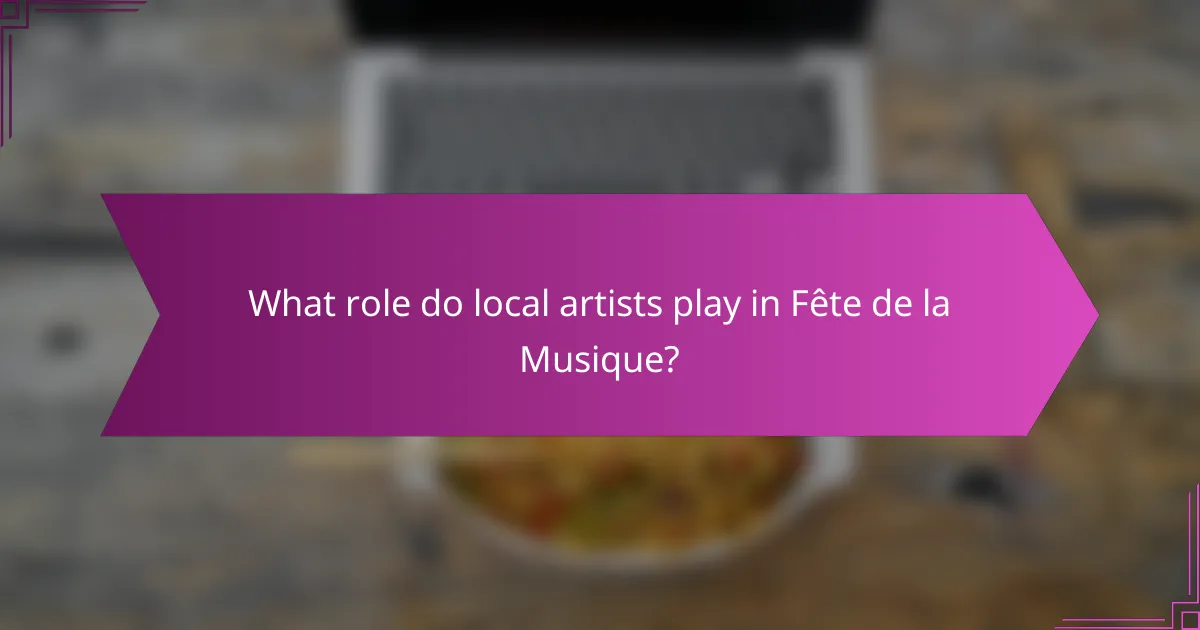
What role do local artists play in Fête de la Musique?
Local artists play a vital role in Fête de la Musique by showcasing diverse musical styles and fostering community engagement. They contribute unique cultural expressions that reflect local traditions and contemporary influences. This celebration promotes inclusivity, allowing artists to connect with audiences through live performances in public spaces. As a result, Fête de la Musique enhances cultural diversity and strengthens local identities.
How do emerging artists benefit from this platform?
Emerging artists benefit from the Fête de la Musique platform by gaining exposure, networking opportunities, and access to diverse audiences. This global celebration allows them to showcase their talent in a supportive environment. The event promotes cultural diversity, enabling artists to connect with different musical styles and traditions. As a result, participants can build their reputation and potentially attract future collaborations or gigs.
What opportunities exist for collaboration among musicians?
Collaboration opportunities among musicians during Fête de la Musique include joint performances, cross-genre projects, and community workshops. These events foster cultural exchange and enhance musical diversity. Musicians can connect with local artists and engage in collaborative art forms, enriching their creative output. Collaborative efforts can also lead to unique musical experiences that celebrate cultural heritage and promote inclusivity.
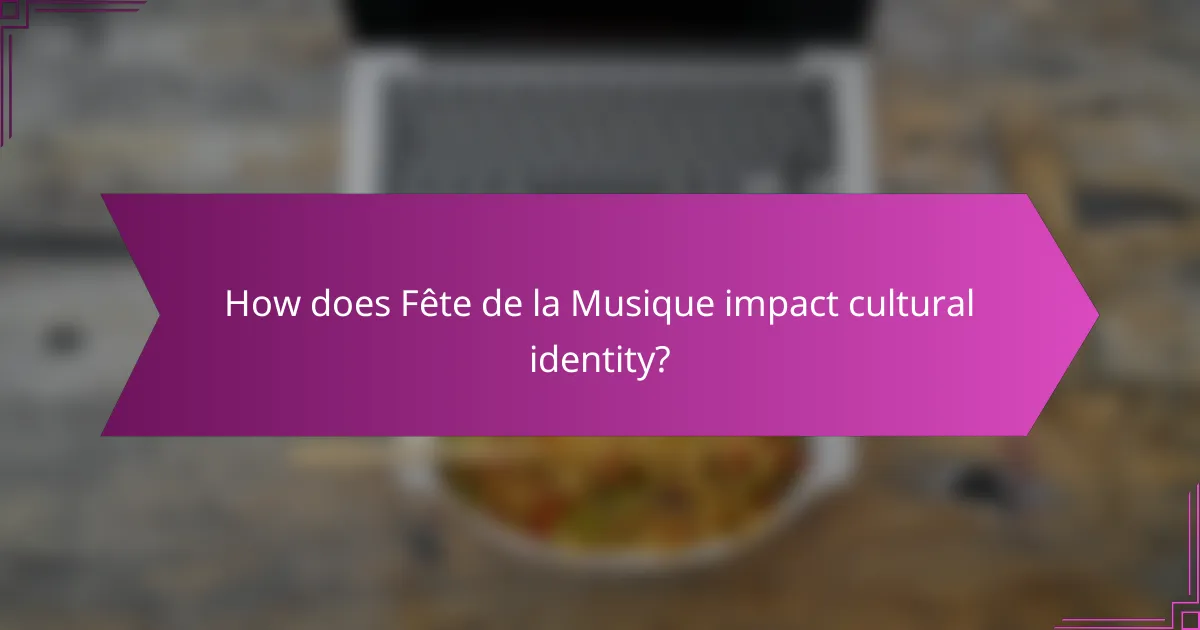
How does Fête de la Musique impact cultural identity?
Fête de la Musique enhances cultural identity by celebrating musical diversity and fostering community engagement. This global event encourages local traditions and promotes cultural exchange. It showcases various music genres, reflecting unique cultural expressions. As a result, it strengthens social bonds and enhances collective identity through shared experiences.
In what ways does the event promote cultural exchange?
The event promotes cultural exchange by uniting diverse musical traditions and artists worldwide. Participants experience various genres, fostering appreciation for different cultures. Local communities engage with international acts, enhancing cross-cultural dialogue. This celebration encourages collaboration, showcasing how music transcends borders and unites people.
How does participation influence community engagement?
Participation significantly enhances community engagement by fostering connections and encouraging collaboration. Events like Fête de la Musique exemplify this by bringing diverse musical expressions together, uniting people through shared experiences. The festival promotes cultural exchange, enabling participants to appreciate global musical diversity while strengthening local community ties. As a result, increased participation leads to heightened interest in cultural initiatives and sustainable community development.
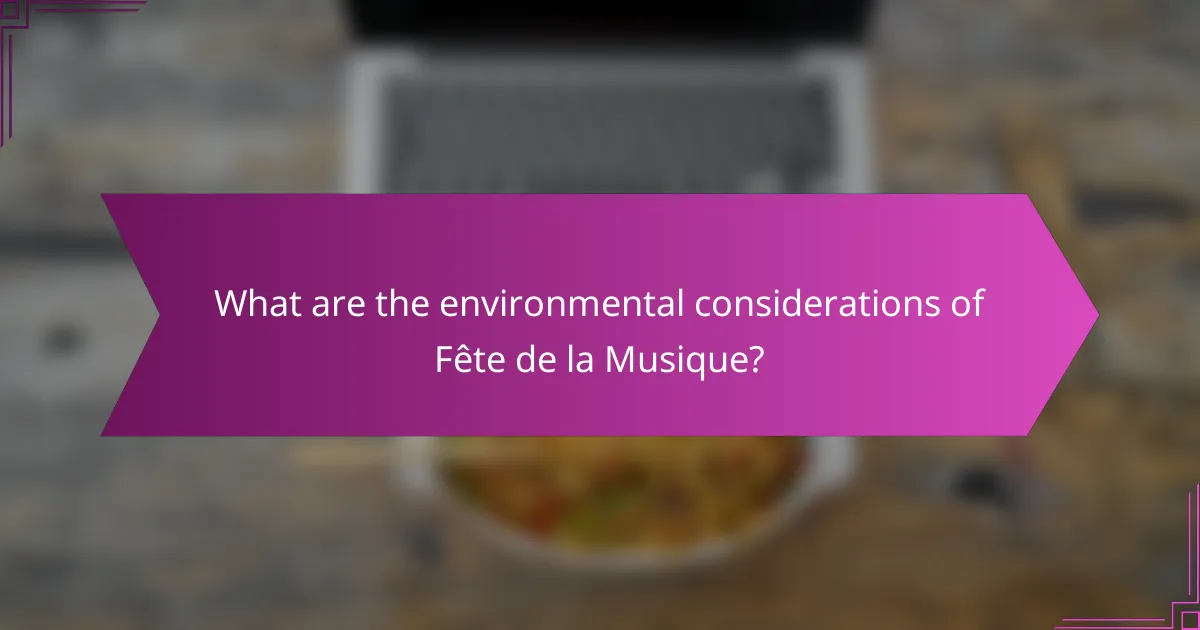
What are the environmental considerations of Fête de la Musique?
Fête de la Musique promotes environmental awareness through sustainable practices and community engagement. Many cities implement eco-friendly measures such as waste reduction, recycling, and the use of renewable energy sources during celebrations. Additionally, local artists often highlight environmental themes in their performances, raising awareness about ecological issues. This cultural event fosters a sense of responsibility towards the environment while celebrating musical diversity.
How do cities manage sustainability during the celebrations?
Cities manage sustainability during celebrations like Fête de la Musique by integrating eco-friendly practices. They implement waste reduction strategies, promote public transport, and encourage local participation. For example, cities may use reusable materials for decorations and provide recycling stations. This approach reduces environmental impact while enhancing community engagement. Additionally, cities often collaborate with local businesses to support sustainable practices, fostering a culture of responsibility.
What initiatives are in place to reduce the event’s carbon footprint?
Fête de la Musique implements various initiatives to reduce its carbon footprint. These include promoting local artists to minimize transportation emissions, encouraging public transport for attendees, and using eco-friendly materials for stages and equipment. Additionally, many events incorporate waste reduction strategies, such as recycling and composting, to further lessen environmental impact.
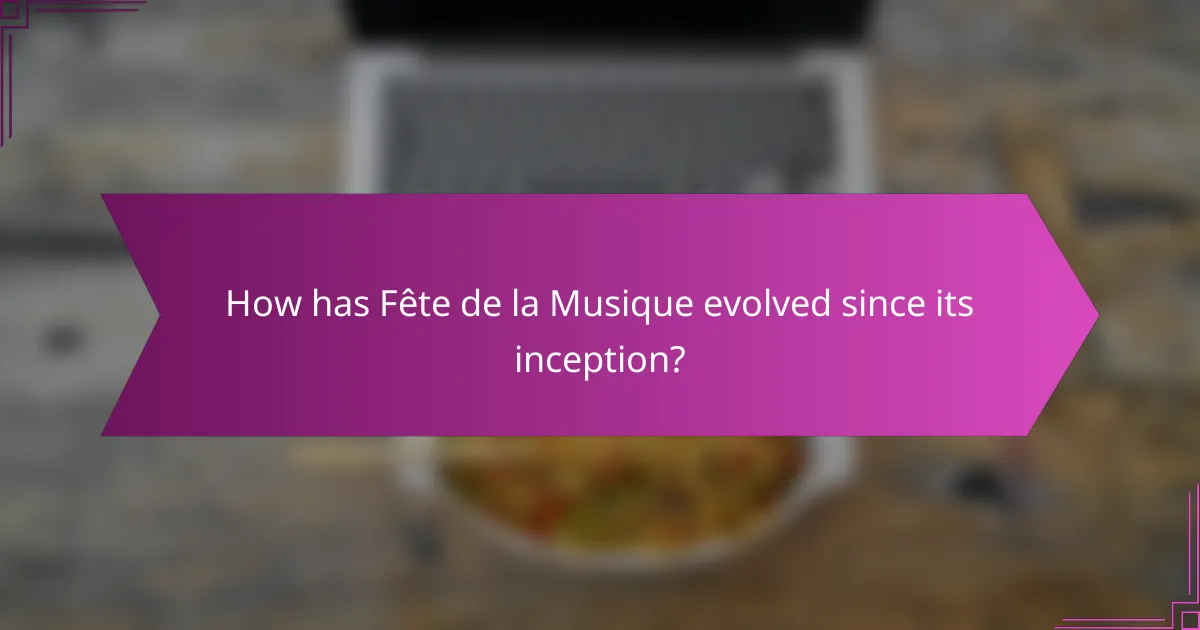
How has Fête de la Musique evolved since its inception?
Fête de la Musique has evolved into a global celebration of music since its inception in 1982. Initially launched in France, it now features diverse musical styles worldwide, promoting cultural exchange and community engagement.
The festival has expanded to over 120 countries, showcasing both amateur and professional musicians. This inclusivity highlights the unique attribute of the event, allowing various genres to be celebrated simultaneously.
As a result, Fête de la Musique fosters cultural impact by encouraging local communities to participate, thus enhancing social cohesion. The rare attribute of spontaneous performances in public spaces adds to the festival’s charm, making it a vibrant expression of musical diversity.
In recent years, digital platforms have further transformed the celebration, enabling virtual participation and broader audience reach. This adaptation reflects the festival’s commitment to innovation while staying true to its roots of celebrating music for all.
What technological advancements have influenced the event?
Technological advancements have significantly influenced the Fête de la Musique by enhancing accessibility and participation. Digital platforms enable global streaming, allowing diverse musical acts to reach wider audiences. Social media promotes local events, creating community engagement and facilitating real-time interaction. Additionally, mobile applications provide event information, schedules, and artist profiles, enriching the overall experience. These innovations foster a vibrant cultural exchange, showcasing the unique musical diversity inherent in this global celebration.
How have global events shaped its current form?
Global events have significantly influenced the Fête de la Musique, shaping its musical diversity and cultural impact. The festival originated in France in 1982, promoting amateur and professional musicians. Since then, it has expanded globally, adapting to local cultures while maintaining its core celebration of music. Events like the fall of the Berlin Wall and the rise of digital platforms have encouraged worldwide participation, enhancing the festival’s reach. As a result, Fête de la Musique now features varied musical genres, reflecting the cultural richness of each participating region.
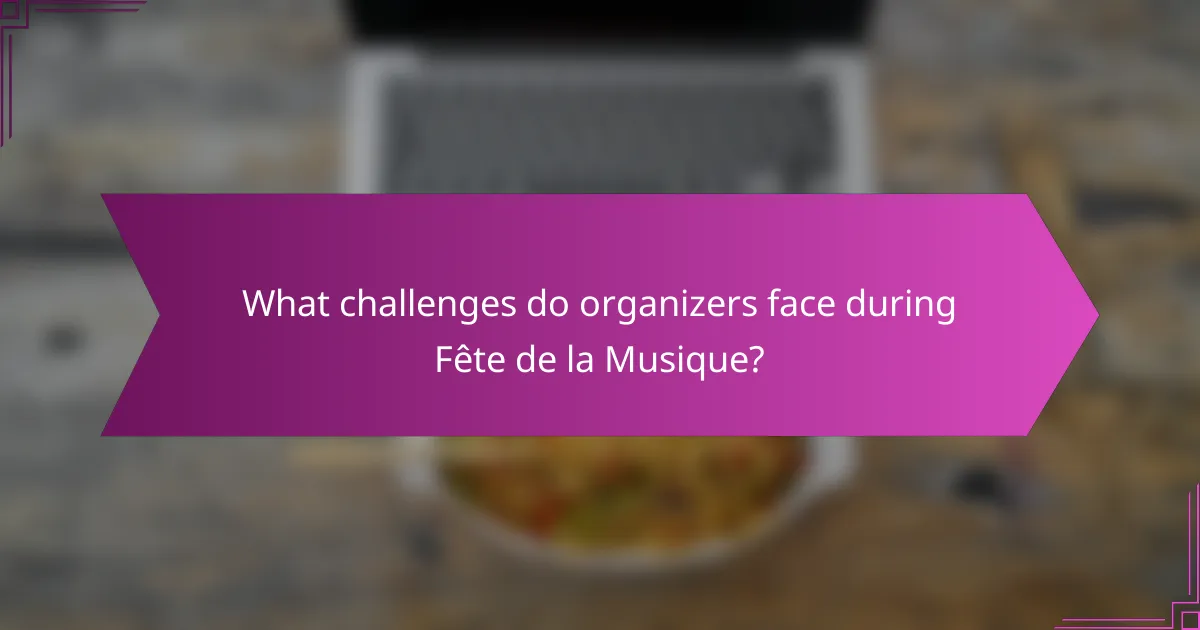
What challenges do organizers face during Fête de la Musique?
Organizers face numerous challenges during Fête de la Musique, including logistical coordination, budget constraints, and ensuring diverse musical representation. Weather unpredictability can disrupt outdoor events, while securing permits and managing sound regulations adds complexity. Engaging local communities and artists is essential but can be difficult, impacting participation. Additionally, promoting the event effectively to attract audiences requires strategic planning and resources.
How do logistical issues affect the success of the event?
Logistical issues significantly impact the success of Fête de la Musique celebrations. Effective planning ensures smooth coordination of performances, venues, and resources. Poor logistics can lead to delays, inadequate sound systems, or overcrowded spaces, diminishing the overall experience. For instance, a lack of proper scheduling may result in overlapping acts, reducing audience engagement. Additionally, accessibility challenges can exclude certain demographics, limiting cultural diversity. Addressing these logistical concerns is crucial for maximizing attendance and enhancing the event’s cultural impact.
What are common pitfalls for organizers to avoid?
Organizers should avoid common pitfalls such as lack of planning, insufficient promotion, ignoring local regulations, and failing to engage the community. Each of these can diminish the success of Fête de la Musique events.
Effective planning involves scheduling performances and securing venues well in advance. Promotion should target diverse audiences to reflect the musical diversity celebrated. Understanding local regulations ensures compliance and smooth execution. Engaging the community fosters enthusiasm and participation, enhancing the cultural impact of the event.
What strategies can improve future celebrations?
Engaging communities and leveraging technology can significantly enhance future celebrations of Fête de la Musique. Organizing local workshops will foster musical diversity and cultural exchange. Utilizing social media platforms can broaden outreach and participation, encouraging global collaboration. Integrating virtual events allows for inclusive participation, connecting diverse audiences. Finally, promoting local artists enhances cultural impact and strengthens community ties.
What best practices can enhance the Fête de la Musique experience?
To enhance the Fête de la Musique experience, focus on community engagement, diverse musical acts, and strategic planning.
1. Foster local participation by encouraging amateur musicians to perform alongside professionals.
2. Curate a diverse lineup that represents various genres and cultures, enriching the festival’s musical diversity.
3. Utilize public spaces effectively, ensuring accessibility and visibility for all performances.
4. Promote the event through social media and local networks to maximize attendance and engagement.
5. Incorporate educational workshops or discussions to deepen the cultural impact of the festival.
6. Gather feedback post-event to continuously improve future celebrations.

